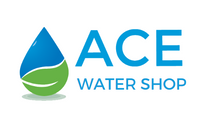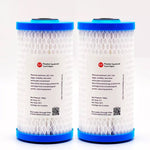You have no items in your shopping cart.
When removing pollutants, odor, and unpleasant tastes from tap water, activated carbon filters are truly amazing. But what are they, and why do you need one? What contaminants does the charcoal water filter remove from your water?
We'll find out in this article!
ACTIVATED CHARCOAL WATER FILTER
Activated carbon filters aren't the same as regular water filters. Instead, it consists of microscopic black beads or a solid black porous sponge processed to improve its ability to trap pollutants selectively. First, heat, steam, or chemicals pumps into the carbon. The process causes millions of microscopic pores to form, greatly increasing the surface area. This activation process increases the number of pores in the carbon, capturing and absorbing a wider range of pollutants, making it a significantly more effective filter media.
Because each carbon particle has a wide surface area, it exposes the contaminants to the active sites within the filter medium to the greatest extent feasible. It allows to absorb or remove more pollutants. One pound (450g) of activated carbon has a surface area of over 100 acres, nearly three times the size of The Pentagon!
More outstanding features of activated carbon make it an effective adsorption medium for removing pollutants from water. Some companies also use it to manufacture respiratory masks and air conditioning systems. Some also use it in exhaust fans to release aromas such as smoke and animal odor.
WHAT CONTAMINANTS DOES CHARCOAL WATER FILTER REMOVES FROM YOUR WATER?
It removes and reduces many contaminants, including chemicals, gases, and physical impurities effectively. According to several studies cited by the United States Environmental Protection Agency (EPA) and NSF International, activated carbon filters remove between 60 and 80 pollutants from water, effectively reduce another 30, and considerably reduce another 22 contaminants. Of course, there are two factors that determine the system's ability to remove or minimize such toxins:
- The kind of activated carbon used (whether GAC or carbon block).
- The activated carbon's quality.
With this in mind, make sure the filter you purchase removes the contaminants that cause problems in your tap water. The EPA recommends activated carbon filtration as the only water treatment system that practically removes all common and recognized herbicides, pesticides, and inorganic pollutants.
Activated carbon filters work to remove and minimize the following types of water contaminants:
PFOS
Perfluorooctanesulfonic acid, or PFOS, is a water and stain-resistant synthetic substance commonly used in carpets, fire-fighting foams, furniture, food packaging paper, clothing fabric, and other water, grease, and stain-resistant materials. Because PFOS chemicals are difficult to degrade, they persist in the environment and drinking water for decades. Overexposure to PFOS at certain levels can cause health problems such as congenital disabilities, malignancies, liver problems, and more. Activated carbon filters, such as PFAS, PFOS, and PFNA, can remove PFAS effectively.
Chlorine
Chlorine is a common water disinfectant in the United States. Almost every public water supplier in the United States treats their water with chlorination before providing it to customers. We use chlorine to fight bacteria off and other organisms that cause foul odors and tastes in water. Studies suggest that those who drink chlorinated water have a 93 percent higher risk than those who consume water that doesn't contain the chemical despite its extraordinary disinfectant properties.
Thankfully, certain activated carbon filters are very effective at removing chlorine and its disagreeable taste and odor. Premium activated carbon filters may effectively remove up to 95% of free chlorine from some water sources.
Chlorine Bi-Products
The most common source of concern regarding tap water is chlorine by-products (VOCs), such as THMs, which have been recognized as potentially carcinogenic. In terms of eliminating these, activated carbon outperforms all other filter technologies. According to the Environmental Protection Agency, it eliminates 32 of the most prevalent chlorine by-products. Total THMs are the most commonly measured in tap water reports.

Phosphate
Phosphate is found in drinking water from various sources, including runoff, human and pet excrement, chemical manufacture, and other sources. Excess phosphate in water can cause a significant rise in algae, leading the water to become hazy due to an algal bloom. Premium charcoal filters routinely remove up to 90% of phosphates in water.
Chloride
Chloride is a key component in the chlorination of drinking water. However, "Chloride concentrations beyond around 250 mg/liter might cause a perceptible salty taste in water...", according to the WHO. Furthermore, high amounts of chloride can harm human health, especially for persons on low-sodium diets or those with certain health problems.
Herbicides
Herbicides have been used in global agriculture for centuries, mostly to control undesired weeds and boost agricultural yield. When you handle these compounds carelessly, they can end up in water sources, causing harm to non-target aquatic organisms and even humans. Herbicides have the potential to cause cancer in humans and a variety of other illnesses and disorders. On the other hand, it shows that activated carbon removes 12 of the most prevalent herbicides, including atrazine and 2,4-D weed killer.
Lithium
Lithium is a naturally occurring trace metal found in soil, mineral formations, and drinking water. It's a stress reliever and antidepressant that you can find in tap water. We must examine the metal's possibly negative impacts on human health until additional observational studies are conducted. Charcoal filters can lower the amount of lithium in drinking water by up to 90%.
Microplastics
Microplastics consist of several types of plastic debris. Determining the precise impact of microplastics on human health is difficult for a variety of reasons. Plastics are available in a range of shapes and sizes, with or without chemical additions. When plastic rubbish enters waterways, it does not disintegrate in the same way that natural materials do. Instead, exposure to the sun's rays, oxygen interactions, and deterioration from physical components like waves and sand break down plastic garbage into small particles. The smallest microplastics reported in published reports are 2.6 microns.
WHAT IT WON'T FILTER
The most common type of activated charcoal used to filter water is activated carbon. It improves water quality by removing chlorine and other impurities, as well as removing undesirable aromas. However, it isn't enough to eliminate certain hazardous chemical compounds, high amounts of metals, fluoride, or infections.
Activated carbon won't filter without special ingredients or further filtration:
- Radionuclides
- Bacteria, viruses, cysts, coliform, protozoa, and other microorganisms are the most common microbiological pollutants
- Heavy metals, copper, or iron in significant concentrations
- Asbestos and arsenic are examples of inorganic contaminants
- Calcium, potassium, and magnesium are all beneficial minerals
- Hydrocarbons or petroleum distillate in large quantities
- Minerals, salts, and metals such as iron that aren't normally regarded pollutants are dissolved solids.

HOW DOES THIS WATER FILTER WORK?
Catalytic reduction or adsorption are two methods for eliminating pollutants. Catalytic reduction removes residual disinfectants such as chlorine and chloramines, whereas adsorption removes organic compounds. It attracts negatively charged pollutant ions to positively-charged activated carbon during the adsorption process. It can also use catalytic reduction to reduce hydrogen sulfide. The acidity and temperature of the water can be important since higher acidity and lower water temperatures help activated charcoal operate better.
FINAL THOUGHTS
If you're concerned about the quality of your drinking water, you might want to look into water purification systems. Water filters range from simple activated carbon filters to reverse osmosis systems, among others and can remove hazardous impurities while also improving the flavor and odor of your water.











